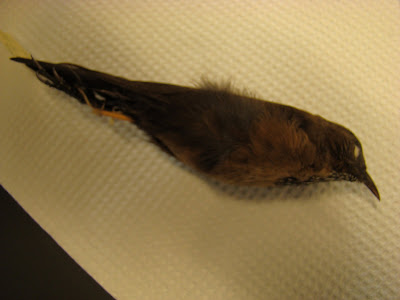SUPERFAMILY SYLVIOODAE - The Old World Insect-Eaters
Family Timaliidae
The Babblers and Wrentits
- 254 species, 44 genera
- Old world tropics and one species on the California coast
- strong pair bonds
- males and females sing (unique)

Family Sylviidae
The Old World Warblers and Kinglets
- diverse group - 361 species, 60 genera
- Old World insectivorous - a few new world species





 SUPERFAMILY CORVIOIDEA
SUPERFAMILY CORVIOIDEA




 Family Cracticidae
Family Cracticidae


 Family Vireonidae
Family Vireonidae

Family Hirundinidae
The Swallows
- nest construction variations that follow evolutionary trends
- cosmopolitan
- insectivorous


Family Alaudidae
The Larks
- 78 species, 16 genera
- Old World (1 new world species)
- great singers (flight song of the males)
- biparental care
- popular culture and Shakespeare's favorite bird

Family Remizidae
The Penduline Tits and Verdin
- Old world (1 new world species)
- elaborate hanging nests
- biparental care

Family Paridae
The Titmice and Chickadees
- Eurasia and North America
- cavity nesters, biparental care
- food storage behavior
 SUPERFAMILY CORVIOIDEA
SUPERFAMILY CORVIOIDEA Family Picathartidae
Rockfowl or Bald Crows
- African
- 2 species
- cave nesters with helpers

Family Corvidae
The Crows and Jays
- 106 species, 26 genera
- cosmopolitan
- among the smartest birds

Family Vangidae
The Vangas
- Madagascar
- Carnivorous


Family Laniidae
The Shrieks
- Cosmopolitan
- 73 species, 11 genera
- carnivorous
- will dry food (insects, small vertebrates, etc) on sharp thorns or barbed wire
 Family Cracticidae
Family Cracticidae The Butcherbirds
- black and white with a large beak with a hook on the end
- babies raised by mother
- Australian
- impale insects on their beak (also males during courtship)

Family Paradisaeidae
The Birds of Paradise
- 42 species, 20 genera
- crow-like morphology
- fruit eating
- monogamous (some), but mostly polygamous
- elaborate plumage and courtship rituals
- nest in the forks of trees

 Family Vireonidae
Family Vireonidae The Vireos
- 43 species, 4 genera
- New World
- appear to be related to shrieks
END SUPERFAMILY CORVIOIDEA (Not in superfamily)




Family Orthonychidae
The Logrunners
- ground-dwellers, bad fliers
- 4 species
- eat insects
- unique hips that allow they to push debris out of their way while walking through underbrush

Family Maluridae
Fairy Wrens
- cooperative breeders
- complex social structures - socially monogamous, breeding-wise polygamous (form pair bonds, have affairs)
- eat insects

Family Meliphagidae
The Honeyeaters
- 172 species, 39 genera
- polygamous with sexual dimorphism
- eat nectar and insects - fill Australian hummingbird niche


Family Ptilonorhyncidae
The Bowerbirds
- monogamous
- 18 species, 8 genera
- polygamous (catbirds are usually monogamous)
- maternal parental care
- awesome bowers - very elaborate, especially in males with less vibrant coloring.








Wow, *so* impressed, thank you so much!
ReplyDeleteHmm, I thought I commented about how awesome you are for posting this, but then my comment never appeared. Oh well, you are still awesome, no matter what Blogspot thinks.
ReplyDelete